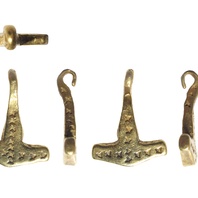
Viking Objects
Hammer-Shaped Pendant (LCNCC: 2015.15)
A gold hammer-shaped pendant with an elongated pentagonal head, popularly called a Thor’s hammer pendant, from Spilsby, Lincolnshire. Hammer-shaped pendants are thought to be amuletic pendants designed to represent Thor’s hammer Mjöllnir. They are common in Scandinavia and in areas of Viking settlement in England. Those found in the Danelaw are generally undecorated or simply decorated, and are thought to have been made in England. The purpose of these pendants has been much speculated about, but nothing definite is known about it. Pendants like this have been found made of lead, copper alloy, silver and gold, showing that many different strata of society could have worn them.
Read More
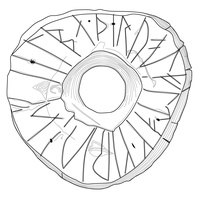
Viking Designs
Drawing of the Saltfleetby Spindle Whorl
Drawing of a lead alloy spindle whorl from Saltfleetby, Lincolnshire showing part of the runic inscription. For further information, see the entry for the original item.
Read More

Viking Objects
Bone Comb with Runic Inscription (1867,0320.12)
An original bone comb case with a runic inscription on it which reads, in translation, “Thorfast made a good comb.” The Vikings were known for looking after their personal hygiene. Combs were not only used for combing your hair but also for removing nits and lice.
Read More
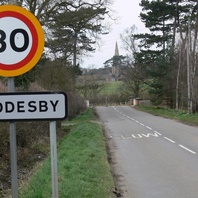
Viking Names
Gaddesby
Gaddesby, in the East Goscote Hundred of Leicestershire, is a Scandinavian compound from the Old Norse male personal name Gaddr, which is an original byname from Old Norse gaddr ‘a goad, a spur’, and Old Norse element by ‘a farmstead, a village’. Alternatively it has been suggested that the first element is Modern English gaddr transferred topographically to the ‘spur of land’ on which the settlement is located. However, it is difficult to conceive the escarpment in which the village sits on as a hill-spur.
Read More
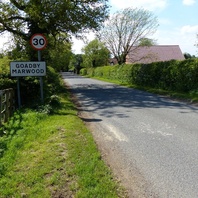
Viking Names
Goadby Marwood
The first element of Goadby Marwood, in the Framland Hundred of Leicestershire, comes from the Old Norse male personal name Gauti (genitive singular Gauta), which is either a short form of names in Gaut- or is derived from an original byname meaning ‘a man from Gautland’. The second element of the place-name is the Old Norse element by ‘a farmstead, a village’. The affix Marwood is the family name of Gaufridus Maureward who held the manor in 1247. The manor remained in the family until at least 1428. The affix Marwood distinguishes the township from Goadby, in the Gartree Hundred of Leicestershire.
Read More
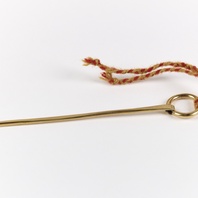
Viking Objects
Reproduction Ring-Headed Pin
A reproduction ring-headed pin used for fastening cloaks. Pins like this were common in Ireland and the western British Isles, and spread further afield under Viking influence.
Read More
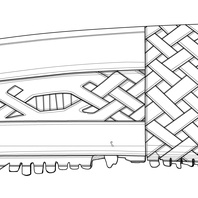
Viking Designs
Drawing of Bone Comb
A drawing of an intricately decorated bone comb found in Lincoln.
Read More
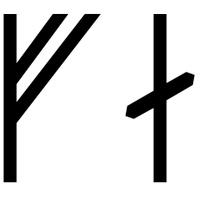
Viking Names
Thorfast
Þorfastr is a common male name in the eastern part of the Viking world – it is common in Swedish runic inscriptions and is even found in the inscription on a rune-stone fragment found in Finland, as well as a couple of Danish ones, but it does not occur in any Norwegian or Icelandic texts. It can be found in the runic inscription on the Lincoln comb-case.
Read More

Viking Names
Spilsby
The name of Spilsby, in the Bolingbroke Wapentake of Lincolnshire, comes from the Old Norse male byname Spillir and the Old Norse element by ‘farm, settlement’.
Read More
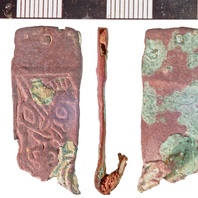
Viking Objects
Borre-Style Strap-End (NLM-F4E3D9)
This strap-end is classified as a Thomas Class E type 4 with Borre-style decoration. Strap-ends came in various styles and were fairly common throughout the Viking world. They were used to decorate the ends of belts and to stop them getting damaged.
Read More
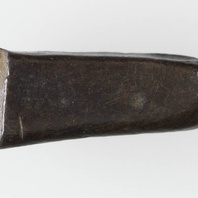
Viking Objects
Silver Ingot (CM.1789-2008)
This silver ingot was made by melting down worked silver cast into a rod and cut into sections. The Vikings arriving in England had a bullion economy where they paid for goods with silver that was weighed to an amount agreed between the buyer and the seller. Hacksilver and silver ingots are the most common evidence for their bullion economy. It took some time for the Scandinavian settlers to adopt a monetary economy like that of the Anglo-Saxons, and both systems were used simultaneously for a while before they fully adopted the new system. They were familiar with monetary economies but they treated coins as just another form of silver before adoption of a monetary economy.
